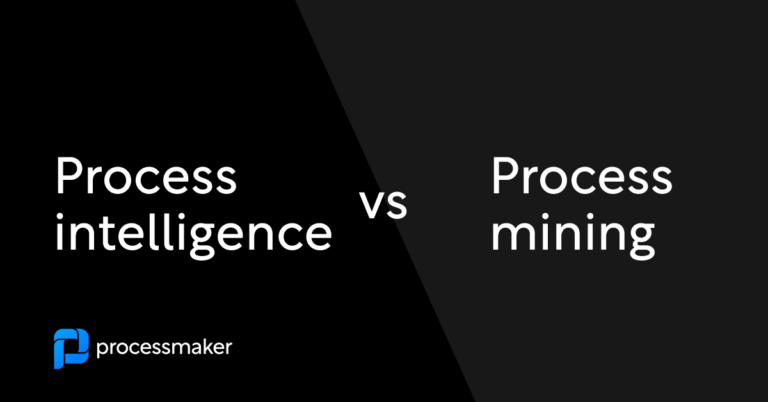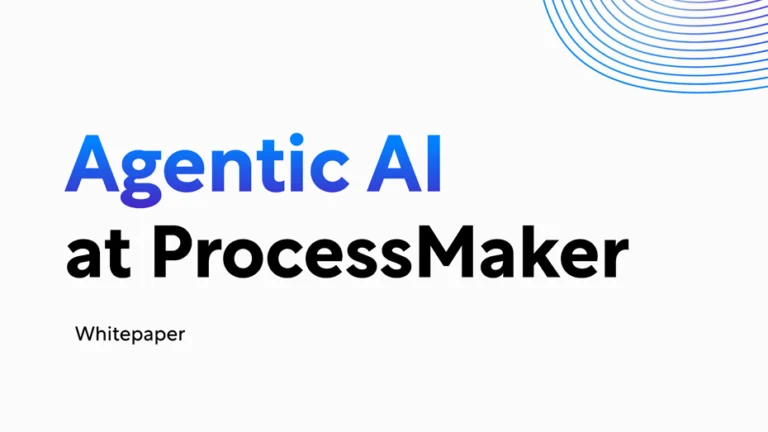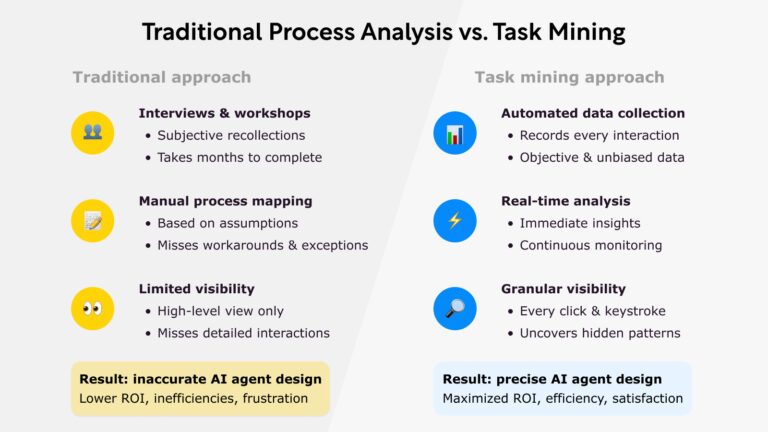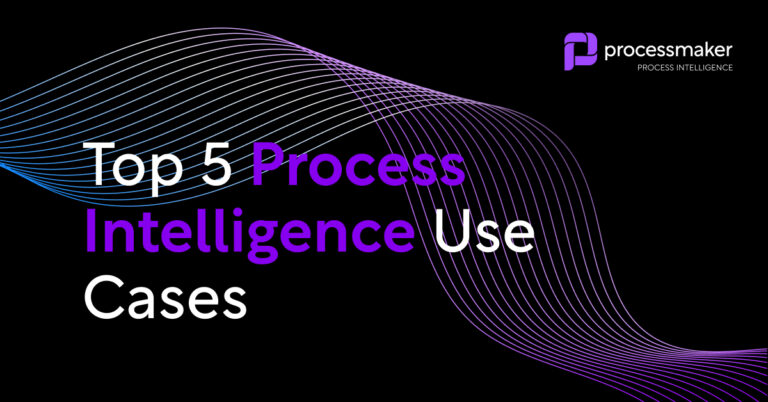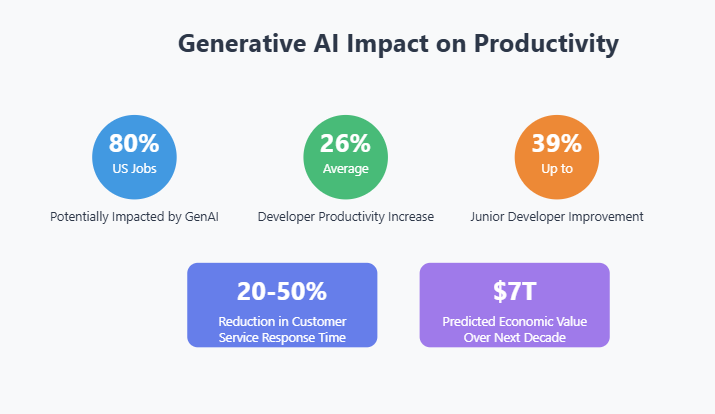Process intelligence and process mining are two powerful methodologies used by businesses to analyze, optimize, and improve their operations. Although they share some similarities, they have distinct differences in terms of their approach, scope, and capabilities.
In this article, we look at the key differences and help you identify which may be most suitable for your needs.
What’s the difference between process intelligence and process mining?
Process intelligence is a comprehensive approach to understanding and optimizing business processes by leveraging data and analytics. Process mining is a subset of process intelligence that focuses on analyzing event logs generated by information systems, such as ERP or CRM applications.
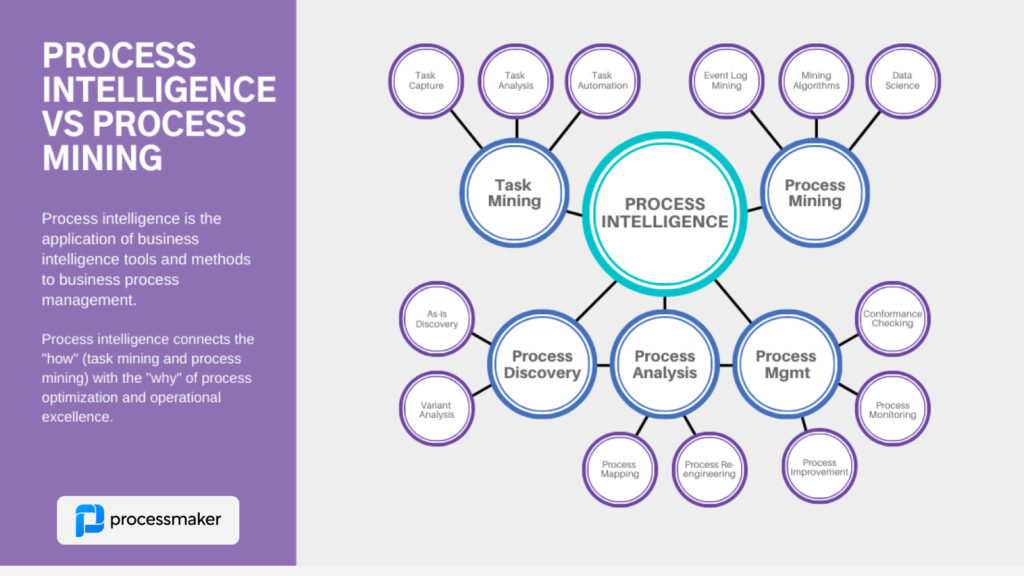
You can consider process intelligence to be an umbrella term for different business intelligence technologies and methodologies including task mining tools and process mining software. In addition, you can consider process intelligence as the connection of the different process analytics tools with the practical implementation of business process management.
Differences between process intelligence vs process mining
On a more detailed level, you can see additional differences in process intelligence and process mining.
- Scope: Process intelligence covers a broader range of processes across an organization, whereas process mining focuses on specific processes that are captured in event logs.
- Data Sources: Process intelligence uses a wider variety of data sources, including structured and unstructured data, while process mining relies primarily on event logs from information systems.
- Approach: Process intelligence takes a more holistic approach to process analysis, encompassing process discovery, monitoring, optimization, and automation. Process mining, on the other hand, primarily focuses on process discovery and analysis.
- Capabilities: Process intelligence offers a wider range of capabilities, such as real-time monitoring, workflow automation, and advanced analytics. Process mining capabilities are more specialized, concentrating on the analysis of event logs to uncover process inefficiencies and bottlenecks.
Advantages of combining task mining and process intelligence
Task mining solutions are another popular type of process intelligence software that compliments process mining. Essentially, solutions are any software solutions that capture task and workflow activity from a desktop or workstation device in order to provide insights on work efficiency, team resourcing, and automation opportunities.
Combining task mining and process mining in your process intelligence strategy offers several advantages that can help optimize business processes and drive operational efficiency. Some of these benefits include:
- Detailed process understanding. Task mining focuses on the granular level of user interactions, while process mining analyzes the end-to-end process flow. By combining both approaches, you can gain a holistic understanding of your processes, from macro to micro levels.
- Root cause identification. The combination of task mining and process mining allows you to identify bottlenecks, inefficiencies, and areas for improvement in your processes. This information enables you to make data-driven decisions and optimize processes at both the individual task and overall process levels.
- Link processes to work patterns. By identifying repetitive, time-consuming tasks through task mining and finding ways to streamline or automate them, you can boost employee productivity and job satisfaction.
- Faster process discovery: Task mining accelerates process discovery by automatically capturing and analyzing user interactions with software applications. Combined with process mining, this can significantly shorten the time it takes to map and understand your organization’s processes.
- End-to-end monitoring and improvement. The integration of task mining and process mining allows for continuous monitoring of your processes, ensuring that you can identify and address emerging issues or inefficiencies promptly, leading to ongoing process improvement.
Three tips for finding the right solution for you
When deciding between process intelligence vs process mining, enterprise leaders should consider the following factors:
- Assessing your business needs. Identify your organization’s specific goals and requirements. Are you primarily focused on compliance and understanding current processes, or do you need real-time insights and predictive modeling capabilities to drive continuous improvement?
- Evaluating tool capabilities. Examine the features and capabilities of available process mining, task mining, and process intelligence tools to determine which approach aligns best with your organization’s needs.
- Integrating with existing systems. Consider the ease of integrating your process intelligence solutions with your existing IT infrastructure and data sources. Ensure that the chosen solution can access the necessary data and work seamlessly with your systems.
The bottom line: valuable insights
Both process intelligence and process mining offer valuable insights and opportunities for process improvement. By understanding the differences between these approaches and carefully evaluating their respective advantages and limitations, enterprise leaders can make informed decisions about which approach is best suited to their organization’s needs.
Q&A:
What is the main purpose of Process Intelligence?
The main purpose of Process Intelligence is to optimize and enhance business processes by providing organizations with deep insights into their processes and enabling them to make data-driven decisions.
What are some common use cases for Process Intelligence?
Common use cases for Process Intelligence include identifying and eliminating bottlenecks, enhancing efficiency, reducing costs, improving compliance, and increasing agility.
Is process mining suitable for all industries?
While process mining can be applied across various industries, it is particularly beneficial for businesses with complex processes and high volumes of data. These organizations can leverage process mining to gain valuable insights into their processes and drive significant improvements in efficiency, cost savings, and customer satisfaction.
What’s the difference between process mining and task mining?
Process mining and task mining both provide insights relevant to business process management, but they work in slightly different ways. Process mining gathers data from event logs in enterprise source systems, while task mining gathers information from the user interface of workstations.
How is process mining different from business intelligence?
Process mining is a subset of business intelligence where you combine BI methodologies and data science techniques to business process management.
